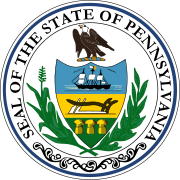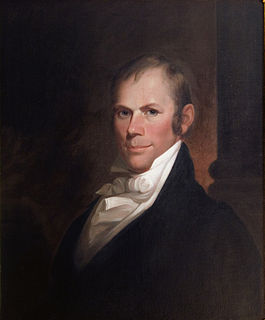On May 20, 1822, Samuel Moore (DR) of Pennsylvania's 6th district resigned. [1] A special election was held on October 1, 1822 to fill the resulting vacancy.
| Elections in Pennsylvania |
|---|
 |
On May 20, 1822, Samuel Moore (DR) of Pennsylvania's 6th district resigned. [1] A special election was held on October 1, 1822 to fill the resulting vacancy.
| Candidate | Party | Votes [2] | Percent |
|---|---|---|---|
| Samuel D. Ingham | Democratic-Republican | 6,131 | 60.5% |
| Samuel Sitgreaves | Federalist | 4,002 | 39.5% |
Ingham took his seat on December 2, 1822. [3]

The 17th United States Congress was a meeting of the legislative branch of the United States federal government, consisting of the United States Senate and the United States House of Representatives. While its term was officially March 4, 1821, to March 4, 1823, during the fifth and sixth years of James Monroe's presidency, its first session began on December 3, 1821, ending on May 8, 1822, and its second session began on December 2, 1822, to March 3, 1823. The apportionment of seats in the House of Representatives was based on the third Census of the United States in 1810. Both chambers had a Democratic-Republican majority.

The 1822 and 1823 United States House of Representatives elections were held at various dates in different states between July 1822 and August 1823 during President James Monroe's second term.

The 1820 and 1821 United States House of Representatives elections were held at various dates in different states between July 1820 and August 1821 as President James Monroe won reelection unopposed.

The 1794 and 1795 United States House of Representatives elections were held on various dates in each state between August 25, 1794, and September 5, 1795 (Kentucky). The election was held during President George Washington's second term.
Peter Sharpe was an American politician who served as a United States Representative from New York.
The 1820 and 1821 United States Senate elections were elections for the United States Senate that, corresponding with James Monroe's landslide re-election, had the Democratic-Republican Party gain one-to-five seats, assuming almost complete control of the Senate.
The 1822 and 1823 United States Senate elections were elections for the United States Senate that had the Democratic-Republican Party continue almost complete control of the Senate.

Maryland elected its members October 2, 1820.

Maryland elected its members October 7, 1822.

The 1822 special election for Maine's 2nd congressional district was to select the successor for Representative Ezekiel Whitman (F), who resigned from his position on June 1, 1822. Mark Harris won the election, and took his seat on December 2, 1822.

In the 1816 elections in Pennsylvania, David Scott (DR) won one of the two seats in the 10th district, but resigned before the 15th Congress began, having been appointed judge of the court of common pleas. A special election was held on October 14, 1817 to fill the resulting vacancy.

Special elections were held in Maryland's 5th congressional district on January 1, 1823, to fill vacancies in the 17th and 18th Congresses caused by the resignation of Samuel Smith (DR) after being elected to the Senate. Smith had been re-elected to the House in October. His resignation therefore created vacancies both in the remainder of the 17th Congress and in the 18th Congress.

On May 15, 1820, David Fullerton (DR) of Pennsylvania's 5th district resigned from his seat in the House of Representatives. A special election was held on October 10, 1820 to fill the resulting vacancy. This election was held on the same day as the election for the 17th Congress.

In April, 1821, prior to the first meeting of the 17th Congress, Representative-elect James Duncan (DR) from Pennsylvania's 5th district resigned. A special election was held to fill the resulting vacancy on October 9, 1821.

On July 20, 1821, William Cox Ellis (F) from Pennsylvania's 10th district resigned. A special election was held to fill the resulting vacancy on October 9, 1821.

On May 8, 1822, the last day of the First Session of the 17th Congress, William Milnor (F) of Pennsylvania's 1st district resigned. A special election was held to fill the resulting vacancy on October 1, 1822, a week before the general elections for the 18th Congress.

On May 8, 1822, the last day of the First Session of the 17th Congress, Henry Baldwin (DR) of Pennsylvania's 14th district resigned from Congress. A special election was held on October 1, 1822 to fill the resulting vacancy.

On October 17, 1822, Ludwig Worman (F) of Pennsylvania's 7th district died in office. A special election was held to fill the resulting vacancy on December 10, 1822

On November 4, 1836, a special election was held in Pennsylvania's 13th congressional district to fill a vacancy left by the October 30th, 1836 resignation of Jesse Miller (J).